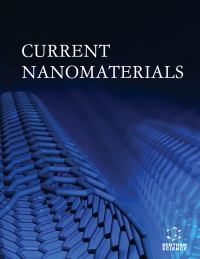- Home
- A-Z Publications
- Current Nanomaterials
- Issue Home
Current Nanomaterials - Current Issue
Volume 10, Issue 2, 2025
-
-
A Mini-review on Properties and Applications of Zinc Oxide Nanoparticles
More LessAuthors: Amruth B.A., Kushala C., Vaibhavi J.G., Rashmi V. and Sanjay K.R.In today’s world, nanoparticles play a pivotal role in revolutionizing many industries. Their nano size enables novel applications that have the potential to address pressing global challenges. The paper reviews the major properties and their practical implementations of Zinc Oxide Nanoparticles (ZnO NPs). Different methods of ZnO NP synthesis produced a surface area ranging from 57m2g-1 to 83m2g-1. A precipit Read More
-
-
-
A Review of the Current Progress of Metal-organic Framework and Covalent Organic Framework Nanocomposite Membrane in O2/N2 Gas Separation
More LessAuthors: Kok Chung Chong, Pui San Ho, Soon Onn Lai, Woon Chan Chong and Siew Hoong ShuitThe use of membrane technology has developed rapidly since the proposal of the Robeson upper bound. Nevertheless, the researchers proposed various methods and techniques to enhance the permeability and selectivity to achieve a breakthrough of the upper bound. Metal-organic framework (MOF) and covalent organic framework (COF) were the recently-interest- arising materials enhancing gas separation perfor Read More
-
-
-
Emerging Trends and Therapeutic Advances of Nanoparticles in the Management of Fungal Diseases: A Comprehensive Review
More LessAuthors: Diya Bhalla, Susha Dinesh and Sameer SharmaThe prevalence of fungi infections has escalated in recent decades. Even though a large portion of fatalities caused by fungal infections are preventive, there is, however, an underappreciated subject for public health officials. Nanotechnology-based carriers have garnered considerable attention owing to their exceptional capabilities. The administration of antimycotic therapeutics with enhanced antifungal activity, bioav Read More
-
-
-
Recent Advances in Nanomaterial-Based Immunotherapy for Prostate Cancer: A Comprehensive Review
More LessAuthors: Amit Kumar, Akshay Kumar Lunawat, Raj Kumar Narang and Manish KumarProstate Cancer (PCa) remains a global health concern, and recent advancements in nanomaterial-based immunotherapy are reshaping the landscape of its treatment. The advent of Prostate-Specific Antigen (PSA) screening had a significant impact on the PCa burden until the early 21st century, but the ongoing innovations in therapeutic approaches and early detection methods have contributed to a decline in mortality r Read More
-
-
-
Preparation of Nano-Metal-Oxide Incorporated Biochar for Remediation of Water Pollution
More LessBy Özgür ArarBackgroundBecause of its numerous advantages, biochar has been widely used to remove contaminants from aqueous media for several years. However, unmodified biochar often exhibits low sorption capacity. Therefore, various nano-sized metal oxides have been developed to modify biochar and improve its ability to remove impurities.ObjectiveThis review aims to provide information on preparing and applying biochar Read More
-
-
-
Nanosensors from Logistics and Supply Chain Perspective: A Literature Review
More LessAuthors: Ilknur Tunc and Goknur Arzu AkyuzIntroductionNanosensors are one of the most recent technologies obtained from the nanoworld. They have enhanced properties with potential applications in a wide spectrum of sectors. They exhibit exceptional properties in temperature monitoring, hazardous gas and vapor detection, humidity detection, as well as pathogens, toxins, and chemical contaminant detection. Among various nanosensor applications, one of t Read More
-
-
-
Environmentally Compatible Poly (Vinyl Alcohol)/Banana Peel Nano Crystals/Bentonite Clay-based Composites Films: Influence of Nano Filler on Biodegradation Behavior
More LessAuthors: Deepak kohli, D.S. Panwar, Balraj Tudu, Jigesh Mehta, Vishal Shah, Jigna Patel, Bital Patel, Ankit D. Oza, Ravi Gupta and Laxman SinghObjectiveThe present work shows the effect of Bentonite Clay (BC) on the biodegradation behavior of Poly Vinyl Alcohol (PVA)/Banana Peel Nano Crystals (BPNC) composite films.MethodBiodegradation studies were conducted using soil burial and bacterial degradation method. The prepared composite films were characterized by scanning electron microscopy.ResultsBiodegradation studies reported that the composite films w Read More
-
-
-
Eco-friendly Synthesis of Silver Nanoparticles using Bignay (Antidesma bunius) Leaves for Antibacterial Application
More LessAuthors: Khent Ivan Duerme, Cathleen Montano, Eliezer Diamante and Noreen Grace FundadorBackgroundFoodborne pathogenic bacteria continue to become a global concern despite the advancements in food packaging technology. Silver nanoparticles (AgNPs) are widely studied in the field as they exhibit desirable inhibitory properties against foodborne pathogens. AgNPs are conventionally synthesized by toxic chemical and physical means; hence, there is a need to seek environmentally safe alternative routes Read More
-
-
-
Antimicrobial Potency of the Biosynthesized Silver Nanoparticles (AgNPs) on Methicillin-Resistant Staphylococcus aureus (MRSA) Using Brideliaferruginea Benth Plant Extract
More LessBackgroundAntibiotic resistance among pathogens has grown to be a major concern for the health of people around the world. One of the main subgroups of troublesome multidrug-resistant bacteria that has recently undergone rapid evolution is Methicillin-resistant Staphylococcus aureus (MRSA).MethodsIn this study, silver nanoparticles were synthesized using an aqueous extract of Bridelia ferruginea leaves. The methicilli Read More
-
-
-
An Investigation into the Additional Potential of Iron-Reducing Bacteria Harnessed for Gold Nanoparticle Synthesis
More LessAuthors: Oluwafemi Bamidele Daramola, Nkem Torimiro and Reama Chinedu GeorgeIntroductionSoil bacteria that synthesize varying metallic NPs are underreported, even though there is a promising mechanism in the bio-reduction of gold salts and the synthesis of gold nanoparticles by different bacterial species.ObjectiveThis study aimed to explore the ancillary potential of some soil microbes obtained from a metal fabricating workshop for gold nanoparticles (AuNPs) synthesis.MethodsTo evaluate the useful Read More
-
-
-
Preparation, Optimization, and in-vitro Release Study of Abemaciclib-Loaded Chitosan Nanocarrier as a New Approach for Breast Cancer Treatment
More LessAuthors: Mohammed Mohanad Ali, Samer Hasan Hussein-Al-Ali and Mike Kh. HaddadAbemaciclib (Abm) is a CDK inhibitor that specifically targets the CDK4/6 cell cycle pathway and has potential anticancer activity. Unfortunately, it has a low solubility and dissolution rate.AimThe aim of this study is to enhance the solubility of Abm by loading it onto a chitosan (CS) polymer.MethodsPolymer nanoparticle (NP) and Abm-CSNPs nanocomposites were prepared. Minitab 18 software was used to design 18 Read More
-
Most Read This Month Most Read RSS feed
Article
content/journals/cnm
Journal
10
5
false
en


